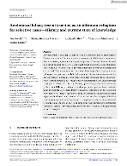Anatomical biliary reconstruction as an ultimum refugium for selective cases-History and current state of knowledge

Author
Ševčík, Jan
Publication date
2024Published in
Journal of Hepato-Biliary-Pancreatic SciencesVolume / Issue
31 (11)ISBN / ISSN
ISSN: 1868-6974ISBN / ISSN
eISSN: 1868-6982Metadata
Show full item recordCollections
This publication has a published version with DOI 10.1002/jhbp.12067
Abstract
Reconstruction of extrahepatic bile ducts is a staple procedure of HPB surgery. The current standard for most cases is a nonanatomical bilioenteric reconstruction, a satisfactory option for the majority of patients. However, it cannot be used for a small number of selective cases (short bowel syndrome, severe abdominal adhesions), where an anatomical reconstruction with or without an interponate can be used. This review summarizes current knowledge about tissue and material usage for experimental and clinical anatomical bile duct reconstruction in the last 100 years. A Pubmed database was searched for published articles about anatomical extrahepatic bile duct reconstruction in experimental and clinical settings ranging from 1920 to 2022. To date, the truly optimal interponate material has not yet been found. However, evidence reveals important properties of such material, most importantly its biodegradability and neovascularization in the recipient's body. The role of internal bile duct stenting for anatomical reconstruction seems important for the outcome. Anatomical reconstruction of extrahepatic bile ducts is an uncommon but usable technique in unique cases when a nonanatomical reconstruction cannot be done. The optimal properties of interponate material for anatomical bile duct reconstruction have been more clarified, although further research is required.
Keywords
bile duct injury, bile duct repair, bile duct stenosis, biliary reconstruction, cholecystectomy
Permanent link
https://hdl.handle.net/20.500.14178/3038License
Full text of this result is licensed under: Creative Commons Uveďte původ-Neužívejte dílo komerčně-Nezpracovávejte 4.0 International







